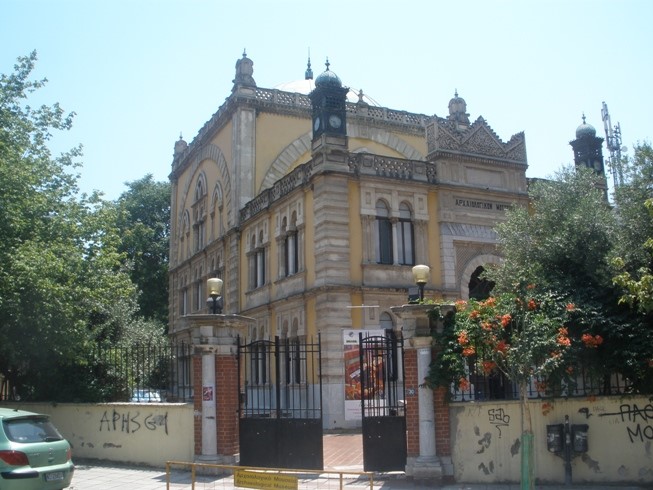In the archaeological abundance provided by the ancient city of Thessaloniki, the greatest attention is paid to the objects from the ancient and Byzantine era, which are clearly marked on the ground, on maps and in tourist manuals. Objects from the Ottoman period, which bear witness to the Jewish or Islamic heritage, are in the background. And one of them, although shrouded in mysticism, and unique in its architecture, seems to have sunk into information darkness. It is hard to find in today’s Thessaloniki, data is not widely available, and there are no signs on it that would inform the visitor about the history and original function of the building. One should not be surprised at such an attitude towards that building, whose real name is Yeni Djami, because it served as a place of worship for one of the most unusual sects in history. To the followers of other faiths they were known as Donmeh, and they called themselves Ma’min. In order to understand this building, it is necessary to first familiarize ourselves with the unusual history of the sect it represents.
Jews in Thessaloniki
When the Christians conquered the last Moorish stronghold in Spain in 1492, the Muslim and Jewish population was expelled. The majority of Muslims settled in North Africa, from where their descendants, unsurpassed pirates, terrorized European ships and coastal settlements for the following centuries. The Jews found their home in the most religiously tolerant country of that time – the Ottoman Empire. A particularly large number of them came to the city of Thessaloniki where, in an unusual national-religious mixture of the population, they represented the relative majority until the tragic wars of the 20th century.
The Jewish community in Thessaloniki was later joined by the Maranos, Jews who originally, in order to avoid persecution from the Iberian Peninsula, converted to Catholicism, and kept the Jewish rituals secret for a long time after that. Nevertheless, the mistrust of the people and the Inquisition towards them was so great, that the constant fear of pogroms eventually drove them to the cities of the Ottoman Empire, and Thessaloniki was also their favorite destination. Despite the fact that at that moment they considered themselves Christians, they had no choice but to convert to Judaism in their new homeland, surrounded by a certain mistrust of “real” Jews.
But soon, things got even more complicated.
The Messiah
In the 17th century, Sabbatai Zevi, a gifted kabbalist from Smyrna (Izmir), declared himself the messiah, and when his kabbalistic calculations were confirmed by another famous cabalist, Nathan of Gaza, the word about it spread like lightning, so Sabbatai’s fame and the frenzy that followed took on enormous proportions. Sabbatai embarked on a series of promotional tours of the Empire, followed by a band of followers and causing great attention, controversy and division wherever he appeared. His visit left a deep impression on the Jews of Thessaloniki, who were sharply divided into supporters and opponents.
The Ottoman authorities, initially indifferent, became more cautious over time, and when a competitor (a fellow messiah) accused him of intending to overthrow the Empire, they could not wait any longer. The authorities didn’t want to kill him, because that would make him a martyr, the movement would strengthen and maybe really threaten the Empire, so they put him in a dilemma. He was offered to either be killed immediately, so if he really is the messiah, let him resurrect beautifully and save the world, or convert to Islam and receive a monetary reward for it. Worldly values were more attractive and Sabbatai Zevi announced in the fateful 1666, when he was supposed to save the world according to the Kabbalah, that he was converting to Islam. …And indeed, he received a state pension, for some time he continued to appear in public, making ambiguous statements, and then retired to Ulcinj, where he died in 1676, under unclear circumstances. A few years later, while traveling through Skopje, his prophet Nathan from Gaza also died.
For his followers, Zevi’s conversion to Islam was tantamount to a cosmic catastrophe and they were faced with a fateful dilemma. Some, dejected, admitted their mistake and returned to the traditional Jewish faith. Others, remaining Jews, continued to maintain the cult of Sabbatai Zevi in deep secrecy, perhaps even to this day. The third, and among them especially the Thessalonians, consistently followed him and accepted Islam, considering it a tactical, temporary move, which, admittedly, no one understands, but whose effects will be clear only later. The latter were called Dönmeh, which is a pejorative term, but we can call them Sabbateans, after the founder of the movement. Let’s note that the members of a typical Sabbatean family were first Jews in Spain, then disingenuously baptized as Maranos, then reluctantly converted to Judaism, then sincerely became followers of Zevi, and then, disingenuously but willingly, converted to Islam.
Dönmeh in Thessaloniki
The Sabbatean sect could survive in the long term only in Thessaloniki, a city where the tradition of exemplary religious tolerance from its former homeland – al-Andalus, Moorish Spain – was continued. Although initially despised apostates, over time they became accepted in the city as a special autochthonous religious group, with all the rights that that status carries. In the religious sense, the Islamic form gradually gained importance in relation to the Jewish substratum and their faith really, after some time, had Islamic as well as Jewish elements, with a particularly pronounced mutual mysticism.
The timing worked for them. The Sabbateans were extremely economically successful and many of them became significantly wealthy, building large, richly furnished villas. Perhaps the family tradition of constant conversions from one faith to another led to a kind of religious relativism, all in all, in the 19th century, Sabbateans became leaders in Europeanization, education and liberal ideas, and thanks to them, Thessaloniki became the most liberal and progressive city in the Empire. They had a significant participation in the Young Turk movement, so in the first Young Turk government, as many as three ministers were Sabbateans. The founder of the Turkish Republic, Mustafa Kemal Ataturk, a native of Thessaloniki, although not from a Sabbatean family, was a student of the Sabbatean school, the best and most free-minded in the city. So, therefore, the evolved Sabbateans, in one way or another, actively participated in the events that ultimately led to the founding of the Republic and the overthrow of the Ottoman Empire, and some see in this the final fulfillment of the mission of Sabbatai Zevi.
The last echo of former glory
Wars in the 20th century fundamentally changed the city. Thessaloniki belonged to Greece, and after the Greek military defeat in Asia Minor, there was a forced exchange of population. The Sabbateans, as a type of Muslim, were officially declared as Turks and in 1923 they were expelled to Turkey, even though they had no linguistic, ethnic, or historical connection with the Turkish people. However, it turned out to be a saving grace for them, because if they had somehow stayed in Thessaloniki, they would have been destroyed in the holocaust twenty years later, and in neutral Turkey they were protected. Most Sabbateans moved to Istanbul, where they were not grouped and where they replaced the Spanish language with Turkish, and for the most part merged with the local Muslims or atheists. It is difficult to estimate how many followers of this religious trend there are in Turkey today, because few of them declare themselves publicly. However, based on rare public examples, it is known that their successors still have a significant impact on Turkish society, always on the side of secularism, enlightenment and liberal ideas.
Although the tradition of Sabbatai Zevi is maintained today by the Dönmeh West association through its website, the only real material remnant of this unusual religious community is Yeni Djami, a building that, albeit under a mimicry name, still stands proudly in the city of Thessaloniki.
Yeni Djami
Yeni Djami (meaning: new mosque, also spelled Yeni Cami, Yeni Jami or Yeni Tzami) is located about 1300 m southeast of the White Tower. After the expulsion of the Muslims, the building served for some time as an Archaeological Museum, which is still written above the entrance, but since a new, magnificent building was built for this purpose, 50 years ago, the building has lost that function and is only opened for occasional exhibitions. The official name of the facility is the Old Archaeological Museum and it is located in a street that is still called the Archaeological Museum Street. If the professional guardians of the architectural heritage deliberately decided on this kind of mimicry in order to protect the building from religious intolerance in turbulent times, they were completely successful in that, because the building can be considered preserved. During his visit to the facility, which was open for a painting exhibition, the author of this text almost woke up two employees who were not used to visitors. There is no entrance fee, visitors are rare, and nothing on the site indicates the real name and history of the object.

The then leading Thessaloniki architect Vitaliano Poselli (1838-1918), who was highly respected in his time, was hired to create the project. He was born in Sicily, and when he was already in his mature years (1886) he moved to Thessaloniki, where in the specific atmosphere of the collapse of the empire, but turbulent intellectual progress, he experienced the peak of his career, working on significant state and religious buildings, and wealthy villas. Among the significant buildings he designed are a synagogue, a Catholic and an Armenian church, two leading banks, a state administration building and the luxurious Allatini villa, where the Young Turks later kept the sultan under house arrest. He was a seasoned architect who skillfully adapted to each project task. He knew the architectural tradition of his city, but also modern styles from the West, which he mixed as necessary and thus, together with his younger colleague, Pierro Arrigoni, shaped the city with a kind of eclectic charm.

Designing a mosque for Sabbateans, originally from Moorish Spain, partly Jewish, partly Muslim, followers of the mystical Kabbalist, and lovers of liberal ideas from the West, was a serious challenge. However, Poselli had been in Thessaloniki for a long time and knew very well what it was all about. He bravely formed a unique building in a style that will never appear again. The result is a fascinating mix of artistic influences linked to the history of that religious community. Corinthian columns, as a feature of local tradition, carry Moorish horseshoe arches that remind of the former homeland. The windows are modeled after the Viennese Orientalists, and there is a ubiquitous decoration of a series of David’s stars, in honor of the old religion, but also arabesques and Arabic calligraphy as a sign of the newly accepted faith. Art Nouveau stained glass is located in the Moorish-Andalusian arch above the entrance, and the building is decorated with two clock towers for the busy new age, but also a sundial for the good old days. The longer the observer looks, he finds more and more stylistic elements from the already neo-,-revival, pseudo-, styles. Neoclassicism, pseudo-Moorish style, Art Nouveau, romantic orientalism, neo-Baroque (…and I probably missed something). It is difficult to imagine the circumstances in which someone would want to build such an object again, and thus Thessaloniki’s Yeni Djami remains the only object of its category, forever alone in time, unique and unrepeatable.

